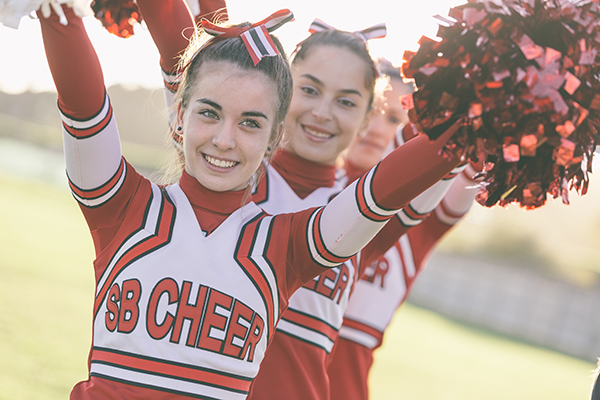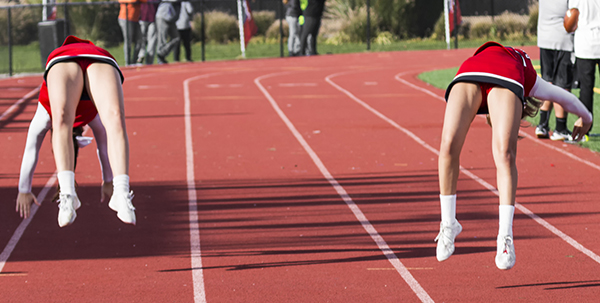August 14th, 2019

Cheerleading has evolved over the last two decades into an athletic pursuit that puts the bodies of young athletes through rigorous routines and training regimens. As a result, the number of injuries reported during cheerleading activities has steadily risen. Cheerleading is now a common cause of injuries among high school and college-age athletes, though the sheer volume of injuries generated from other sports is still greater. Most of those cheerleading injuries fall into the category of orthopedic injuries, and therefore require care from a skilled knee, ankle, or foot doctor.
Modern cheerleading combines elements of gymnastics, tumbling, dance, and acrobatics. As a result, injuries can be sustained to many of the joints in the legs and arms, including the knees, ankles, elbows, wrists, and shoulders. While cheerleading may result in fewer injuries than many other high school and college sports, the types of injuries that do occur are often quite severe. For example, ankle breaks sustained during cheerleading accidents can be so severe that they may require the care of an orthopedic sports medicine specialist in Atlanta. Keep reading to learn more about the injuries that most often result from cheerleading.
Sprains
Sprains are common in many sports involving young athletes, but they tend to be more serious when sustained during cheerleading. Cheerleading prominently features many types of athletic moves that result in stretched ligaments and sprains, such as sharp pivots, aggressive changes of direction, and erratic weight shifts. Those movements not only increase the chances of a sprain injury, but those injuries tend to be debilitating in the short term.
Fractures
The bones of the human body are quite resilient, but they can only tolerate so much before they crack, splinter, and even break catastrophically. Fractures sustained in cheerleading run the gamut from stress fractures caused by repeated shock or repetitive movements to more severe compound fractures that stem from failed acrobatic movements that stress the skeleton immensely. They are common in the hands, wrists, feet, and ankles, but they aren’t limited to those areas. Even the slightest fracture is problematic, but serious breaks require surgical intervention and physical therapy to repair and restore full function.

Muscle Tears and Strains
Because of the acrobatic, explosive movements often required during cheerleading exercises, muscle strains and tears can be common for cheerleaders. Quick shifts and pivots that require muscular exertion can cause the muscle fibers to snap, creating painful injuries. Many muscle tears are the result of improper warm-ups, which leaves the muscles vulnerable to damage when stretched taut suddenly. Muscle tears associated with cheerleading are common the groin, hamstring, back, and hips.
Concussions
Concussions are one of the most dangerous types of orthopedic injuries that can be sustained in high school athletics, and cheerleading isn’t immune to head injuries. Concussions have the potential to be life-threatening if left untreated. The long-term ramifications of concussions are still being studied, but it’s known that the impact of sharp blows to the head resulting in concussions can persist and be magnified years after the injury occurred. While concussions may be more frequent in sports involving direct physical contact, such as football, cheerleaders can sustain concussions when they tumble during stunts and strike their heads on the floor, or when a falling teammate strikes another in the head with a limb, knee, or elbow.
Cheerleading may not seem like a contact sport, and it’s true that it may have a lower rate of injuries than other high school athletic pursuits. However, cheerleaders suffer a wide variety of serious orthopedic injuries that require immediate care from an orthopedic specialist. If you’re a cheerleader in the Atlanta area and you’ve suffered an injury, visit OrthoAtlanta.com to find the location closest to you.
Back






